英语语法专项:动词不定式与一般将来时
高考英语语法专项:一般将来时

2019年高考英语语法专项:一般将来时一般将来时一般时包括一般现在时、一般过去时、一般将来时和一般过去将来时。
今天我们学习一般将来时。
一般将来时的构成一般将来时是由“will / shall + 动词原形”构成的。
shall只限于第一人称,主要见于英国英语,现在的趋势是第一、二、三人称的单复数形式均用will表示。
在口语中,shall和will常缩写成“‘ll”,紧接在主语之后。
其否定式shall not 和will not 常简略为shan’t 和won’t。
例句:I’ll go and shut the door.我去关门。
When will you know your exam results?你什么时候能知道考试结果?I can see you’re busy, so I won’t stay long.我看得出你很忙,所以我不会呆太久的。
提示:在you and I或both of us等短语后,只用will,不用shall。
You and I will arrive there next Monday.我和你下周一都要到达那里。
Both of us will graduate from middle school next year.我们俩明年中学毕业。
2. 一般将来时的用法①表示将要发生的动作或存在的状态I shall be free this afternoon.我今天下午有空。
There’ll be no chemistry classes tomorrow.明天没有化学课。
They will probably go to Shanghai for their holiday.他们可能去上海度假。
注意:在口语中,常用will / shall + be doing结构来代替will / shall + 动词原形,以表示生动。
I’ll be seeing a friend off at the airport.我要去机场给一个朋友送行。
初中同步人教版八年级上册Unit10专项综合全练(三)一般将来时、动词不定式、祈使句、情态动词can

初中同步人教版八年级上册Unit 10 If you go to the party, you1 I I have a great time!专项综合全练(三)一般将来时、动词不定式、祈使句、情态动词canmightshouldv条件状语从句学校:姓名:班级:考号:一、单项选择1.put any relish(调味品)on the turkey sandwich.A. NoB. NotC. Don'tD. Doesn't2.We our holidays in Hong Kong next year.A. visitedB. spentC ・ are going to visitD. are going to spend3.—Why are you so excited?——Because Peter invited me on a trip to Huangshan.A. to goB. goC. goingD. will go4.Wang Lin is trying English because she plans to England.A. learn, to goB. to learn, goingC. learning, to goD. to learn, to go5.. the project as planned, they need to work two more hours a day.A. To finishB. FinishingC. FinishD. To be finished6.My classmate is jumping so far! I believe my eyes.A. shouldn*tB. needn'tC. mustnftD. can't7.Please the rubbish into different litter bins according to the signs.A. putsB. putC. to put8.Nobody can hear you you speak in a louder voice.A. unlessB. ifC. whenD. after9.Gina has the flu and she go to the doctor.A. shouldB. canC. mayD. mustn't10.—I to Hainan on vacation with my parents this coming summer holiday.一That's great!A. goB. wentC. will goD. have gone11. A CCTV news reporter will come to interview Wang Lin tomorrow. Please tell her 这事。
高中英语语法专项精讲-非谓语动词讲解

非谓语动词非谓语动词包括不定式(to do)、动名词(-ing)、现在分词(-ing)与过去分词(-ed)。
它们不受主语人称和数的限制,动词不定式定义:动词不定式是非谓语动词的一种,它没有人称和数的变化,在句子中不能独立作谓语,但它仍保持动词的特点,一、不定式的意义1. 不定式的一般式:一般式表示的动作或状态发生在谓语动词表示的动作或状态的同时或之后。
当不定式的逻辑主语是这个不定式所表示的动作的承受者时,不定式一般要用被动式(to be done).eg: He seemed to be tired. The building to be finished next month is for our teachers.2. 不定式的进行式:进行式表示动作正在进行,与谓语的动作同时发生。
e.g. When I went to his home, he happened to be traveling around the world.3. 不定式的完成式:如果不定式所表示的动作或状态发生在谓语动词所表示动作或状态之前,就用完成式;若是在此基础上的被动含义,就用完成被动式( to have been done).e.g. He is said to have written a novel about the Long March.He is said to have been taught French when he was a child.4. 不定式的完成进行式:如果不定式的动作是在谓语所表示的时间之前一直在进行或有可能继续进行的动作,就要用完成进行式.eg: We’re happy to have been working with the experts all the month.二、不定式的用法:1. 不定式做主语:不定式做主语一般表示具体的某次动作。
而动名词doing 表示习惯的,经常的动作。
一般将来时的动词不定式

一般将来时的动词不定式用法示例
以下是一些用法示例:
1. 表示将来的打算或意图:
- 我计划明天去购物。
- 他打算参加一场音乐会。
2. 表示将来的能力或可能性:
- 我不会在那个时间出席会议。
- 他可能赢得这场比赛。
3. 表示将来的预测或推测:
- 明天会下雨。
- 据说他们将会结婚。
注意事项
1. 不定式常与情态动词连用,如 can, could, may, might, will, would 等。
2. 动词不定式一般不与表示将来时间的副词连用,因为不定式本身已经表示将来。
3. 不定式前可以加情态动词的否定形式,如 can't, couldn't, won't, wouldn't 等。
总结
一般将来时的动词不定式用于表示将来某个时间点或事件发生的动作或状态。
它可以表示打算、意图、能力、可能性、预测等。
在使用时要注意与情态动词的搭配以及不与表示将来时间的副词连用。
希望以上内容对你有所帮助。
> 注意:以上内容是根据一般将来时的用法和常见规则总结而来,具体应用时请根据实际语境和语法规则进行判断和运用。
英语语法:一般将来时解释集

英语语法:一般将来时解释大全一、基本定义一般将来时是英语时态的一种,表示将来的动作或状态。
它主要用于描述未来的计划、预测或期望发生的事情。
二、形式构成一般将来时的构成主要有以下几种形式:1. 基本结构:主语+ will /shall + 动词原形+ 其他成分。
这是最基本的一般将来时形式,表示将来的动作或状态。
2. be going to 结构:主语+ be(am, is, are)going to + 动词原形+ 其他成分。
这种结构表示计划或安排将要发生的事情,也可以表示根据目前的迹象或情况预测将会发生的事情。
3. be+动词不定式:主语+ be(am, is, are)to + 动词原形+ 其他成分。
这种结构表示计划或安排将来要做的事情。
4. be+动词ing:主语+ be(am, is, are)+ 动词ing形式+ 其他成分。
这种结构表示即将发生的动作,通常与“when”连用。
5. be+表示时间的介词短语:主语+ be(am, is, are)+ 表示时间的介词短语。
这种结构用于表示将来某个时间点的情况。
6. 将来时间状语:tomorrow, next week, in the future等以上就是一般将来时的主要构成形式。
需要注意的是,在具体使用时,应根据语境和上下文选择合适的构成方式。
三、用法场景1. 表达未来的计划或意图,例如:I will go to the beach next summer.2. 描述未来的预测或期望,例如:It will rain this afternoon.3. 在条件句中表示将来的结果,例如:If you study hard, you will pass the exam.四、与其他时态的区别1. 与现在进行时态的区别:现在进行时态强调正在进行的动作,而一般将来时态强调将来的动作或状态。
2. 与过去时态的区别:过去时态表示过去的动作或状态,与将来时间无关。
一般将来时态知识点详解(初中英语专项复习) (4)
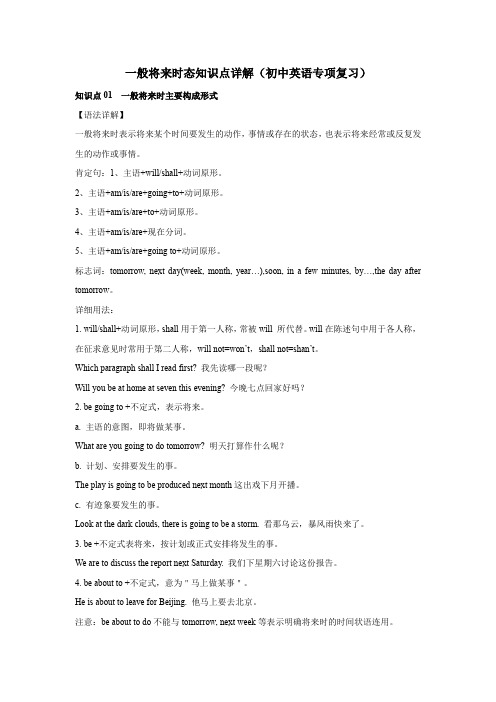
一般将来时态知识点详解(初中英语专项复习)知识点01 一般将来时主要构成形式【语法详解】一般将来时表示将来某个时间要发生的动作,事情或存在的状态,也表示将来经常或反复发生的动作或事情。
肯定句:1、主语+will/shall+动词原形。
2、主语+am/is/are+going+to+动词原形。
3、主语+am/is/are+to+动词原形。
4、主语+am/is/are+现在分词。
5、主语+am/is/are+going to+动词原形。
标志词:tomorrow, next day(week, month, year…),soon, in a few minutes, by…,the day after tomorrow。
详细用法:1. will/shall+动词原形,shall用于第一人称,常被will 所代替。
will在陈述句中用于各人称,在征求意见时常用于第二人称,will not=won’t,shall not=shan’t。
Which paragraph shall I read first? 我先读哪一段呢?Will you be at home at seven this evening? 今晚七点回家好吗?2. be going to +不定式,表示将来。
a. 主语的意图,即将做某事。
What are you going to do tomorrow? 明天打算作什么呢?b. 计划、安排要发生的事。
The play is going to be produced next month这出戏下月开播。
c. 有迹象要发生的事。
Look at the dark clouds, there is going to be a storm. 看那乌云,暴风雨快来了。
3. be +不定式表将来,按计划或正式安排将发生的事。
We are to discuss the report next Saturday. 我们下星期六讨论这份报告。
八年级下册英语语法重点

八年级下册英语语法重点一、一般将来时1.基本结构:主语+ will/shall + 动词原形+ 其他。
2.用法:表示将来要发生的动作或状态。
常与表示将来的时间状语连用,如tomorrow, next week, next year等。
3.注意事项:在否定句中,有时可以用shall not代替will not。
二、现在完成时1.基本结构:主语+ have/has + 过去分词+ 其他。
2.用法:表示过去发生的动作对现在造成的影响或结果。
常与already, just, yet等副词连用。
3.注意事项:have/has gone to表示“去某地了”,have/has been to表示“曾经去过某地”。
三、情态动词1.基本结构:情态动词+ 动词原形+ 其他。
2.用法:表示说话人的语气或情态,如能、可以、应该等。
常用的情态动词有can, may, must, shall等。
3.注意事项:情态动词后接动词原形,不能接动词的-ing形式。
四、被动语态1.基本结构:主语+ be动词+ 过去分词+ 其他。
2.用法:表示主语是动作的接受者。
常与by引导的方式状语连用,如by machine, by air等。
3.注意事项:被动语态的时态变化主要通过be动词的变化来实现,不同时态的被动语态需要注意与该时态的主动语态相对应。
五、不定代词和冠词用法1.不定代词:表示泛指或不确定的代词,如some, any, other等。
some用于肯定句,any用于否定句或疑问句;other表示“其他的”。
2.冠词:表示特指或泛指的词,分为定冠词the和不定冠词a/an。
a用于辅音音素开头的单词前,an用于元音音素开头的单词前;the 表示特指或上文提到的某个名词。
3.用法:不定代词和冠词一起使用时,可以构成限定词短语,如some books, the school gate等。
限定词短语可以修饰名词,表示特指或泛指的概念。
4.注意事项:在英语中,不定代词和冠词的使用是有规则和限制的,需要根据上下文和语境来判断使用哪个代词或冠词。
高中英语不定式与将一般将来时讲义
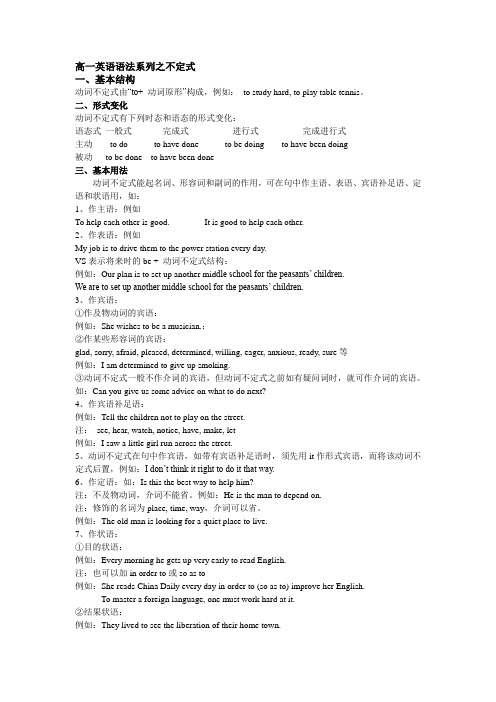
高一英语语法系列之不定式一、基本结构动词不定式由“to+ 动词原形”构成,例如:to study hard, to play table tennis。
二、形式变化动词不定式有下列时态和语态的形式变化:语态式一般式完成式进行式完成进行式主动to do to have done to be doing to have been doing被动to be done to have been done三、基本用法动词不定式能起名词、形容词和副词的作用,可在句中作主语、表语、宾语补足语、定语和状语用,如:1、作主语:例如To help each other is good. It is good to help each other.2、作表语:例如My job is to drive them to the power station every day.VS表示将来时的be + 动词不定式结构:例如:Our plan is to set up another mid dle school for the peasants’ children.We are to set up another middle school for the peasants’ children.3、作宾语:①作及物动词的宾语:例如:She wishes to be a musician.;②作某些形容词的宾语:glad, sorry, afraid, pleased, determined, willing, eager, anxious, ready, sure等例如:I am determined to give up smoking.③动词不定式一般不作介词的宾语,但动词不定式之前如有疑问词时,就可作介词的宾语。
如:Can you give us some advice on what to do next?4、作宾语补足语:例如:Tell the children not to play on the street.注:see, hear, watch, notice, have, make, let例如:I saw a little girl run across the street.5、动词不定式在句中作宾语,如带有宾语补足语时,须先用it作形式宾语,而将该动词不定式后置,例如:I don’t think it right to do it that way.6、作定语:如:Is this the best way to help him?注:不及物动词,介词不能省。
中考语法知识点归纳动词时态语态与非谓语动词
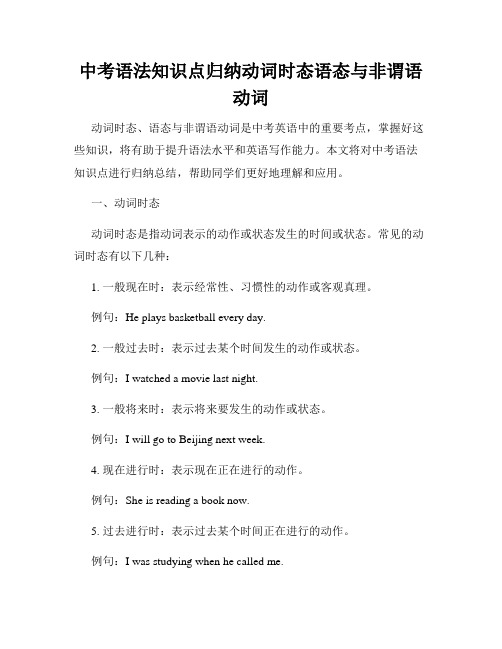
中考语法知识点归纳动词时态语态与非谓语动词动词时态、语态与非谓语动词是中考英语中的重要考点,掌握好这些知识,将有助于提升语法水平和英语写作能力。
本文将对中考语法知识点进行归纳总结,帮助同学们更好地理解和应用。
一、动词时态动词时态是指动词表示的动作或状态发生的时间或状态。
常见的动词时态有以下几种:1. 一般现在时:表示经常性、习惯性的动作或客观真理。
例句:He plays basketball every day.2. 一般过去时:表示过去某个时间发生的动作或状态。
例句:I watched a movie last night.3. 一般将来时:表示将来要发生的动作或状态。
例句:I will go to Beijing next week.4. 现在进行时:表示现在正在进行的动作。
例句:She is reading a book now.5. 过去进行时:表示过去某个时间正在进行的动作。
例句:I was studying when he called me.6. 现在完成时:表示过去的动作对现在造成的影响或结果。
例句:She has visited Paris three times.7. 过去完成时:表示对过去某个时间之前发生的动作进行的描述。
例句:They had already left when I arrived.二、动词语态动词语态是指动作发出的主体和动作所受的影响关系。
英语中常见的动词语态有以下几种:1. 主动语态:表示主语是动作的发出者。
例句:He fixed the car yesterday.2. 被动语态:表示主语是动作的承受者。
例句:The car was fixed by him yesterday.3. 进行时态:表示主语正在进行的动作处于进行状态。
例句:The book is being read by her.4. 完成时态:表示主语已经完成的动作处于完成状态。
例句:The book has been read by her.注意:被动语态需要根据动作的时态来变换,同时需要适当更改时态动词。
语法-动词不定式与一般将来时

英语语法篇之动词不定式动词不定式用法灵活多样;尽管有些动词或短语后面既可以接to do 又可以接doing ,但只要用心观察,发现还是可以找到规律的。
与其说是动词不定式,到还不如说是动词“定式”。
因为我们可以大体上把它分为三类形式,即: do / to do / doing动词不定式没有人称和数的变化,在句中不能独立作谓语,是非谓语形式的一种。
但动词不定式具有名词、形容词和副词特征,在句中可以作主语、宾语、宾语补足语、定语、表语和状语等多种成分。
另外,动词不定式具有动词特点,可以有自己的宾语和状语,组成动词不定式短语。
动词不定式的基本(肯定)形式是to+do,有时可以不带to;其否定形式是not to+do。
1.作主语可以直接作主语。
如:To see is to believe.但在英语中,常用it作形式主语,真正的主语即动词不定式放在后面。
如:It's wrong to play tricks on other people.It's our duty to keep our environment clean and tidy.规律:动词不定式在句中作主语时,常放在It is +adj.(形容词)+to do sth.或It is +n.(名词)+to do sth.句型中,it仅作形式主语。
2.作宾语常可接动词不定式作宾语的动词有:agree(同意), hope(希望), decide(决定), need(需要), mean(打算), wish(希望), fail(失败), want(想要), begin(开始), would like(想要等。
Ask(请求), beg(乞求), leave, like, love, hate(讨厌), prefer(宁愿), order(命令), teach, (教)tell,(告诉)believe(相信), find,(找出)know,(知道)want,(想要)think,(认为)understand,(明白)a.want,decide ,agree等动词后面跟并且只能跟不定式。
七年级英语语法大全
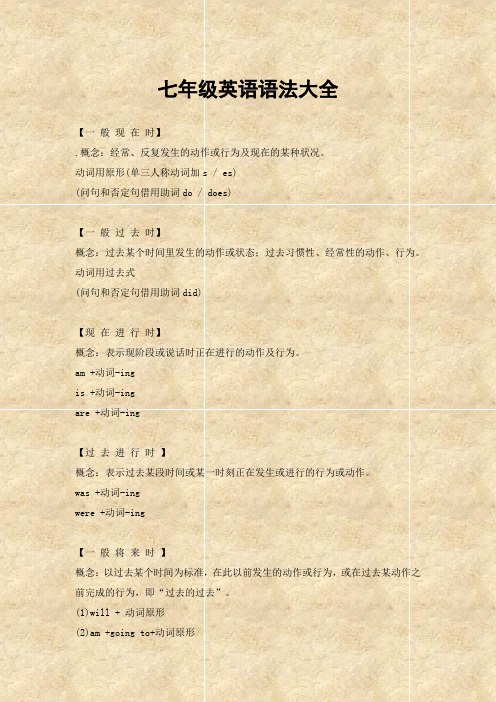
七年级英语语法大全【一般现在时】.概念:经常、反复发生的动作或行为及现在的某种状况。
动词用原形(单三人称动词加s / es)(问句和否定句借用助词do / does)【一般过去时】概念:过去某个时间里发生的动作或状态;过去习惯性、经常性的动作、行为。
动词用过去式(问句和否定句借用助词did)【现在进行时】概念:表示现阶段或说话时正在进行的动作及行为。
am +动词-ingis +动词-ingare +动词-ing【过去进行时】概念:表示过去某段时间或某一时刻正在发生或进行的行为或动作。
was +动词-ingwere +动词-ing【一般将来时】概念:以过去某个时间为标准,在此以前发生的动作或行为,或在过去某动作之前完成的行为,即“过去的过去”。
(1)will + 动词原形(2)am +going to+动词原形Is +going to+动词原形are +going to+动词原形【过去将来时】概念:立足于过去某一时刻,从过去看将来,常用于宾语从句中。
(1)would + 动词原形(2)was +going to+动词原形were +going to+动词原形【现在完成时】概念:过去发生或已经完成的动作对现在造成的影响或结果,或从过去已经开始,持续到现在的动作或状态。
have +过去分词has +过去分词【过去完成时】概念:以过去某个时间为标准,在此以前发生的动作或行为,或在过去某动作之前完成的行为,即“过去的过去”。
had +过去分词1. 不定式定义:由to+动词原形构成。
不定式是一种非限定性动词。
而非限定动词是指那些在句中不能单独充当谓语的动词,可分为不定式,动名词,现在分词和过去分词。
2.用途:在句中不能作谓语。
它具有动词的性质,本身可以带宾语和状语。
【动词不定式】1.定义:动词 + 不定式2.用途:动词不定式在句中可以作句子任何成分。
动词不定式的被动形式除了一般形式外还有其完成式和进行式。
[编辑本段][动词不定式的时态、语态]动词不定式可以作以上各种成分,但它毕竟是动词,所以有动词的属性动词不定式及其短语还可以有自己的宾语、状语,虽然动词不定式在语法上没有表面上的直接主语,但它表达的意义是动作,这一动作一定由使动者发出。
(语法专练)初中英语语法 一般将来时练习题含答案

初中英语:一般将来时专项练习题1.Many roads ______ for the coming Winter Olympics next year. A.build B.will build C.are built D.will be built 【答案】D【解析】【详解】句意:明年冬季奥运会将修建许多道路。
考查语态和时态辨析。
A. build一般现在时的主动语态;B. will build一般将来时的主动语态;C. are built一般现在时的被动语态;D. will be built一般将来时的被动语态。
根据时间next year可知此句的时态是一般将来时;根据语境可知用被动语态,结合语境、句意和选项可知选D。
2.It is reported that a space station ______ on the moon in a few years. A.was built B.will be builtC.is built D.has been built【答案】B【解析】【详解】试题分析:句意:据报道,几年后月球上将要建空间站。
表示几年后将要发生的动作,用一般将来时态,主语space station是谓语动词build的承受者,用被动语态。
故选B。
考点:考查动词的时态、语态辨析。
3.The villagers expect that the building of the bridge ____ before the rainy season comes.A.is completed B.was completed C.will be completed D.has been completed【答案】C【解析】【详解】句意:村民们希望在雨季到来之前完成这座桥的建设。
is completed 是一般现在时的被动语态,被完成;was completed一般过去时的被动语态;will be completed一般将来时的被动语态;has been completed现在完成时的被动语态。
小学英语“一般将来时”语法知识

小学英语“一般将来时”语法知识一、概念表示将来某个时间要发生的动作或存在的状态,常与一些表示将来的时间状语连用。
例如:I am going to/will watch a football match on TV this evening.今天晚上我将在电视上看一场足球比赛。
二、一般将来时的形式❆will 常简略为'll,并与主语连写在一起,如:I'll,he'll,it'll,we'll,you'll,they'll。
❆一般疑问句如用Will you…?其简略答语须是Yes,I will或No,I will not;如用Shall you…?(较少见)其简略答语须是Yes,I shall.或No,I shall not.。
三、一般将来时的用法❆表示将来的动作或状态一般将来时常与一些表示将来的时间状语连用,如:tomorrow(明天),next week (下周),from now on(从现在开始);in the future(将来)等。
❆表示将来经常发生的动作。
一般将来时表示将来某一时刻的动作或状态,其表达形式除了“shall(第一人称),will(第二、三人称)+动词原形构成”外,还有以下几种形式。
1)“to be going to+动词原形”表示即将发生的或最近打算进行的事。
例如:①It is going to rain. 要下雨了。
②We are going to have a meeting today. 今天我们开会。
2)go,come,start,move,sail,leave,arrive,stay等可用进行时态表示按计划即将发生的动作,例如:I'm leaving for Beijing.我要去北京。
3)“be to+动词原形”表示按计划要发生的事或征求对方意见。
例如:①Are we to go on with this work?我们继续干吗?②The boy is to go to school tomorrow.这个男孩明天要去上学。
专题动词不定式一般将来时

用一般现在时态表示将来
主将从现
主将从现练习:
(
A
)1.─We_____ ─Oh,what
home if a pity!
there
is
no
bus.
A.will walk B.have walked C.walked D.walk
( D )2.I don't know if it ____ tomorrow, if it _____, I _____ at home.
be going to与will的区别
will
未经事先考虑的意图,临时决定的。
be going to 事先考虑好的意图,或根据某种迹象得出.
If you want to go, I’ll meet you at 5 o’clock. (临时的决定)
I feel terrible, I think I’m going to be sick. I’m going to be 16 years old next year. Look at the clouds! It’ s going to rain! (表示有迹象要发生某一动作时,要用be going to)
作
表
我的梦想是成为一名歌手。
语
My dream is to be a singer.
2
他的工作是每天清扫教室。
His job is to clean the classroom every day.
第一步是要找到一个你信任的人倾诉。
The first step is to find someone you trust to talk to.
一般将来时的结构变化: 主语+be going to+动原
人教版英语八年级上册 Unit6-7语法重点:一般将来时_专项讲解与练习 (有答案)
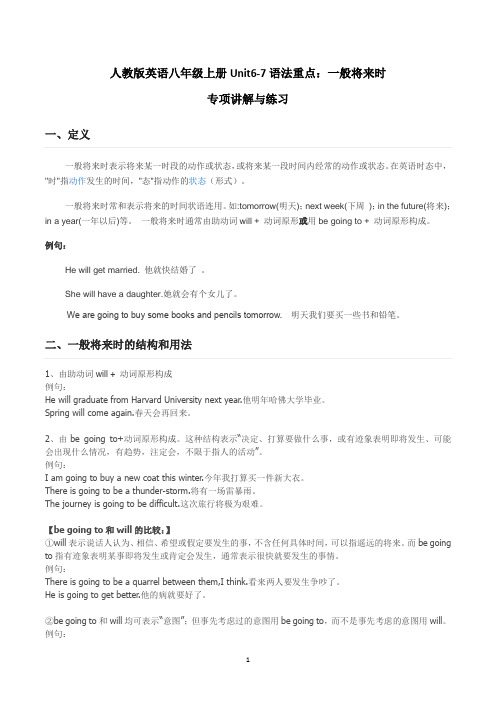
人教版英语八年级上册Unit6-7语法重点:一般将来时专项讲解与练习一般将来时表示将来某一时段的动作或状态,或将来某一段时间内经常的动作或状态。
在英语时态中,"时"指动作发生的时间,"态"指动作的状态(形式)。
一般将来时常和表示将来的时间状语连用。
如:tomorrow(明天);next week(下周);in the future(将来);in a year(一年以后)等。
一般将来时通常由助动词will + 动词原形或用be going to + 动词原形构成。
例句:He will get married. 他就快结婚了。
She will have a daughter.她就会有个女儿了。
We are going to buy some books and pencils tomorrow. 明天我们要买一些书和铅笔。
1、由助动词will + 动词原形构成例句:He will graduate from Harvard University next year.他明年哈佛大学毕业。
Spring will come again.春天会再回来。
2、由be going to+动词原形构成。
这种结构表示“决定、打算要做什么事,或有迹象表明即将发生、可能会出现什么情况,有趋势,注定会,不限于指人的活动”。
例句:I am going to buy a new coat this winter.今年我打算买一件新大衣。
There is going to be a thunder-storm.将有一场雷暴雨。
The journey is going to be difficult.这次旅行将极为艰难。
【be going to和will的比较:】①will表示说话人认为、相信、希望或假定要发生的事,不含任何具体时间,可以指遥远的将来。
而be going to指有迹象表明某事即将发生或肯定会发生,通常表示很快就要发生的事情。
(完整word版)一般将来时练习题及答案学习(可编辑修改word版)

A.arehavingB.aregoingtohaveC.willhavingD.isgoingtohave
()22.
you
freenextSunday?
A.Will;areB.Will;beC.Do;beD.Are;be
()23.Hethereattentomorrowmorning.
A.doB.willdoC.goingtodoD.willdoing
()18.Tomorrowheinthepark.
akiteintheopenairfirst,andthen
boating
A.willfly;willgoB.willfly;goesC.isgoingtofly;willgoesD.flies;willgo
()28.–Let’sgoouttoplayfootball,shallwe?–OK.I.
eD.amcoming
()29.ItusalongtimetolearnEnglishwell.
A.takesB.willtakeC.spendsD.willspend
②Theboyistogotoschooltomorrow.这个男孩明天要去上学。四.“beaboutto+动词原形”表示即将发生的动作,意为:很快,
马上。后面一般不跟时间状语。例如:
Weareabouttoleave.我们马上就走。
五.某些词,如come,go,leave,arrive,start,get,
A.Yes,pleaseB.Yes,youwill.C.No,please.D.No,youwon’t.
()26.Ittheyearofthehorsenextyear.
语法专练初中英语:一般将来时练习题附答案解析50题

初中英语:一般将来时专项练习题1.I want to ask the teacher whether the meeting __________ tomorrow.A.holds B.is held C.will hold D.will be held 【答案】D【解析】【详解】句意:我想要问老师明天是否会开会。
holds举行,是第三人称单数形式;is held一般现在时态的被动语态;will hold一般将来时;will be held一般将来时的被动语态。
根据句中的tomorrow可知,这里应用一般将来时态。
whether引导的宾语从句中主语the meeting和动词hold是被动关系,故应选D。
2.The 31th Olympic Games in Rio de Janeiro (里约热内卢) of Brazil in 2016.A.is held B.will holdC.will be held D.is going to hold【答案】C【解析】【详解】试题分析:句意:第三十一届奥运会将在2016年在巴西里约热内卢举办。
此题考查一般将来时的被动语态。
A是一般现在时的被动;B 一般将来时的主动;C一般将来时的被动;D一般将来时的主动。
根据句意,故选C。
【考点定位】考查一般将来时被动语态的用法。
3.The third line of Zhengzhou Subway by the end of December of 2020.A.will complete B.was completed C.is completingD.will be completed【答案】D【解析】【详解】句意:郑州地铁三号线将于2020年12月底建成。
考查动词时态辨析。
by the end of意为“到……末为止”,后可跟过去时间与过去完成时连用,也可跟将来时间,而与将来时连用。
本句by the end of December of 2020(到2020年12月底)用于一般将来时,可排除BC两项。
人教版英语八年级上册 Unit6-7语法重点:一般将来时_专项讲解与练习 (有答案)

人教版英语八年级上册Unit6-7语法重点:一般将来时专项讲解与练习一般将来时表示将来某一时段的动作或状态,或将来某一段时间内经常的动作或状态。
在英语时态中,"时"指动作发生的时间,"态"指动作的状态(形式)。
一般将来时常和表示将来的时间状语连用。
如:tomorrow(明天);next week(下周);in the future(将来);in a year(一年以后)等。
一般将来时通常由助动词will + 动词原形或用be going to + 动词原形构成。
例句:He will get married. 他就快结婚了。
She will have a daughter.她就会有个女儿了。
We are going to buy some books and pencils tomorrow. 明天我们要买一些书和铅笔。
1、由助动词will + 动词原形构成例句:He will graduate from Harvard University next year.他明年哈佛大学毕业。
Spring will come again.春天会再回来。
2、由be going to+动词原形构成。
这种结构表示“决定、打算要做什么事,或有迹象表明即将发生、可能会出现什么情况,有趋势,注定会,不限于指人的活动”。
例句:I am going to buy a new coat this winter.今年我打算买一件新大衣。
There is going to be a thunder-storm.将有一场雷暴雨。
The journey is going to be difficult.这次旅行将极为艰难。
【be going to和will的比较:】①will表示说话人认为、相信、希望或假定要发生的事,不含任何具体时间,可以指遥远的将来。
而be going to指有迹象表明某事即将发生或肯定会发生,通常表示很快就要发生的事情。
语法专练 初中英语语法 一般将来时练习题

初中英语:一般将来时专项练习题1.More money ____________ when we use both sides of paper. A.will save B.was saved C.has saved D.will be saved 【答案】D【解析】【详解】句意:当我们使用两面纸时,会节省更多的钱。
考查动词的时态和语态。
此句是when引导的时间状语从句,时态是主将从现,可知主句使用一般将来时。
根据句意可知Money被省的,需要使用被动语态,故此句是一般将来时的被动语态。
故选D。
2.-The Big Parade(大阅兵) in Russia has made a big hit in the world and another one on September 3rd, 2015,in China.-Yes, I can't wait to meet the excitement.A.was held B.is heldC.has been held D.will be held【答案】D【解析】【详解】试题分析:句意:——俄国的大阅兵在世界上取得了很大成功,并且又一次大阅兵将在2015年九月三日在中国举行。
——我迫不及待地要满足兴奋。
根据语意句子用一般将来时的被动语态,故答案选D。
考点:考查时态和语态。
3.Have you heard that the 2022 Winter Olympics ______________ in Beijing?A.held B.are held C.were held D.will be held 【答案】D【解析】【详解】句意:你听说了吗,2022年冬季奥运会将在北京举行?held举行,过去式或过去分词;are held一般现在时的被动语态;were held一般过去时的被动语态;will be held一般将来时的被动语态。
根据句意the 2022 Winter Olympics是还没有发生的事情,并且与动词hold 构成被动关系,故应用一般将来时的被动语态,故应选D。
- 1、下载文档前请自行甄别文档内容的完整性,平台不提供额外的编辑、内容补充、找答案等附加服务。
- 2、"仅部分预览"的文档,不可在线预览部分如存在完整性等问题,可反馈申请退款(可完整预览的文档不适用该条件!)。
- 3、如文档侵犯您的权益,请联系客服反馈,我们会尽快为您处理(人工客服工作时间:9:00-18:30)。
英语语法篇之动词不定式动词不定式用法灵活多样;尽管有些动词或短语后面既可以接to do 又可以接doing ,但只要用心观察,发现还是可以找到规律的。
与其说是动词不定式,到还不如说是动词“定式”。
因为我们可以大体上把它分为三类形式,即: do / to do / doing动词不定式没有人称和数的变化,在句中不能独立作谓语,是非谓语形式的一种。
但动词不定式具有名词、形容词和副词特征,在句中可以作主语、宾语、宾语补足语、定语、表语和状语等多种成分。
另外,动词不定式具有动词特点,可以有自己的宾语和状语,组成动词不定式短语。
动词不定式的基本(肯定)形式是to+do,有时可以不带to;其否定形式是not to+do。
1.作主语可以直接作主语。
如:To see is to believe.但在英语中,常用it作形式主语,真正的主语即动词不定式放在后面。
如:It's wrong to play tricks on other people.It's our duty to keep our environment clean and tidy.规律:动词不定式在句中作主语时,常放在It is +adj.(形容词)+to do sth.或It is +n.(名词)+to do sth.句型中,it仅作形式主语。
2.作宾语常可接动词不定式作宾语的动词有:agree(同意), hope(希望), decide(决定), need(需要), mean(打算), wish(希望), fail(失败), want(想要), begin(开始), would like(想要等。
Ask(请求), beg(乞求), leave, like, love, hate(讨厌), prefer(宁愿), order(命令), teach, (教)tell,(告诉)believe(相信), find,(找出)know,(知道)want,(想要)think,(认为)understand,(明白)a.want,decide ,agree等动词后面跟并且只能跟不定式。
如:We agreed to start early. She wants to be a doctor.b.love,like ,begin,start,hate ,prefer等词后面可以接不定式。
规律:上述动词后面除接不定式外,还可以接动名词,意思无很大区别。
贴士:like doing指经常性动作,而like to do指一次性的动作。
如:I like swimming,but I don't like to swim now.我喜欢游泳,但我现在不想游。
c.stop,forget,remember,go on ,try等词或短语后面可以接不定式。
规律:上述动词后面接不定式和接动名词意思大不相同。
贴士:1)stop to do sth.:停止一件事,去做另一件事。
2)stop doing sth.:停止正在做的事。
例句:When the teacher came in,the students stopped talking;when he came out,the students stopped to talk.当老师走进来时,学生们停止说话;当老师走出去时,学生们又开始说话。
自己思考:forget,remember,go on,try等词或短语后面接不定式和动名词用法的区别(后续详情见最后的“动名词与不定式的区别”)remember to do 记住要做某事remember doing 记得曾经做过某事forget to do忘记要做某事forget doing 忘记曾经做过某事stop to do 停下来去做某事stop doing 停止做某事go on to do 继续做另一件事go on doing 继续做原来在做的事d.在find/feel/think+it+adj.+to do sth.句型中,it是形式宾语,真正的宾语是后面的动词不定式。
如:The man downstairs found it difficult to get to sleep.I feel it easy to recite the text.规律:某些动词或短语后面既可以接动词不定式作宾语,又可接动名词作宾语,二者用法上的区别可以通过造句子加以区分,如上stop例句。
3.作宾语补足语a.tell,ask,want,order,teach,invite,warn,wish,help,get等词后面常接不定式作宾补。
如:I tell him not to go there by bus .Edison's mother taught him to read and write.b.let,make,have,see,hear,feel,watch,notice后面接不带to的不定式作宾补。
如:The boss makes them work 16 hours a day.I heard her sing in the next room.贴士:若变成被动语态,在上述结构中,不定式符号to要加上。
如:They are made to work 16 hours a day by the boss.She was heard to sing in the next room.4.作定语:放在被修饰的名词、代词后面如:I have a lot of work to do.The doctor said he could do nothing to help the boy.规律:动词不定式若在句中作定语,常放在被修饰的名词、代词之后。
贴士:如果动词不定式和前面所修饰的词构成动宾关系,若动词是不及物动词,切记不要忘掉介词。
如:I have a small bedroom to live in.Have you got some pens to write with?5.表语:放在连系动词be后面例句:His wish is to become a scientist.The first important thing is to save the soldiers'lives.当务之急是抢救战士们的生命。
规律:动词不定式在句中作表语时,通常对连系动词前面的名词进行诠释说明。
6.作状语a.目的状语:放在go,come,use,live,in order等词后面。
如:I come to see you.He runs fast in order to get there in time.b.原因状语:放在sorry,glad,surprised,disappointed,excited等词后面。
如:I am glad to see you here. I am sorry to trouble you.c.作结果状语。
如:Some of the apples are hard to reach.The room is large enough to hold 1000 people.7.与what,who,whose,when,where,how等疑问词连用,作宾语、宾语补足语、主语等。
如:I don't know what to do next.(宾语)He taught us how to use the computer.(宾语补足语)It's still a question how to get there.(主语)后面跟动词不定式的动词口诀有:三个希望两答应(wish hope want promis agree)两个要求莫拒绝(ask beg refuse )想要明白跟知道(would like understand know )教会告诉要相信(teach tell believe )找出爱恨区别点(find love hate )8、(1)“疑问词+ 动词不定式”结构可以作动词know、think、find out 等的宾语。
eg: I don’t know who to ask. 我真不知道该问谁。
(2)“疑问词+ 动词不定式”可以作动词show、teach、ask等后面的直接宾语。
eg: She told me where to find the earphone. 她告诉我什么地方可以找到耳机。
9、动词不定式可以作介词的宾语。
Autumn harvest is about to start. 秋收即将开始。
I’m worrying about what to do next. 我正愁下一步该怎么办。
10、不定式复合结构作主语时,需注意:(1)It’s + 形容词+ for / of + sb + to do sth. 当上面的形容词指的是to do sth的性质时,用介词for。
It’s dangerous for children to swim in the river.孩子在这条河里游泳很危险。
(游泳这件事情危险)(2)当上面的形容词指的是sb的性质时,用介词of。
这些形容词往往修饰人:good, bad, polite, unkind, kind, nice, clever, right, wrong, careful, carelessIt was careless of you to do that. 你这么做真粗心。
(你这个人粗心)11、感官动词hear, see, feel, watch, notice, look at, listen to后面直接跟动词原形, 即常见的形式为: hear sb do sth等感官动词后既可跟动词原形作宾补,也可跟v-ing作宾补,前者表示动作的全部过程已结束;后者表示动作正在进行。
Many people like to watch others play games. 许多人喜欢看别人玩游戏.I saw him come downstairs.我看见他下了楼。
(说明他下楼了这件事)I saw him coming downstairs.我看见他在下楼。
(说明他下楼时的情景)12、It takes sb some time to do sth.花费某人一段时间干某事.eg: It took me half an hour to do my homework yesterday.昨天我花了半小时做回家作业.It took Jim an hour and a half to read the book.吉姆花了一个半小时看这本书.*用汉字表述上面的句型为:It + take + 人+ 一段时间+ to do sth.一段时间形式往往为:fifteen minutes15分钟,an hour一个小时,two days两天, half a month半个月,a year and a half一年半...等等1) 现在时:一般现在时表示的动词,有时与谓语动词表示的动作同时发生,有时发生在谓语动词的动作之后。
